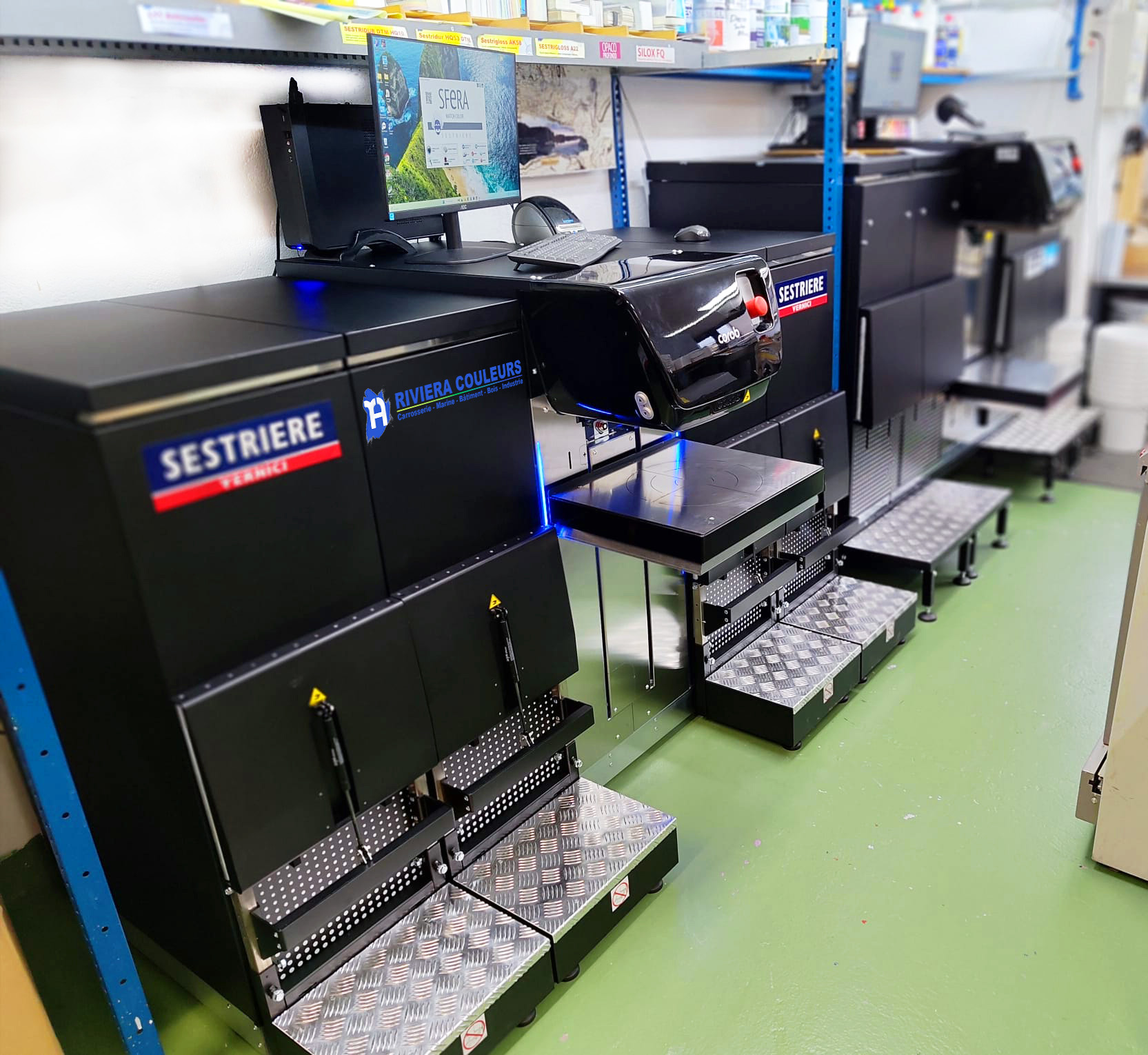The different types of visual defects in bodywork and industrial painting
Paint defects can result from a variety of application errors, improper environmental conditions, or inappropriate product choices. Here is a detailed guide to each defect, with precise explanations and solutions.
- 1. Drips
- 2. Water stains
- 3. Marbling
- 4. Bubbling
- 5. Grains
- 6. Orange peel
- 7. Formation of marks with raised edges
- 8. Discoloration of the peroxide hardener in the putty
- 9. Sanding scratches
- 10. Low opacity
- 11. Moisture blisters
- 12. Low adhesion – polyester putty
- 13. Lifting and curling
- 14. Stitches in the polyester
- 15. Matting/glossing
- 16. Poor adhesion to plastic
- 17. Silver halos
- 18. Corrosion
- 19. Fading/changing color
1. Drips
Cause : Runs occur when paint is applied too thickly, due to incorrect viscosity, poor application technique, or improper gun settings. Inadequate spray pressure or low ambient temperatures can also aggravate this problem.
Prevention : Ensure that the gun is correctly adjusted, maintain a working temperature of around 20°C, and follow the manufacturer's technical instructions for the choice of thinners and hardeners.
Solution : Sand the affected area to smooth the surface and buff to restore uniformity. If necessary, sand the area and reapply using the appropriate viscosity and temperature settings.
2. Water stains
Cause : Water spots occur when the topcoat has not dried completely, or when the film is too thick. Incorrect use of thinner or incorrect proportion of hardener mixture can also cause this defect.
Prevention : Respect drying times between coats, and ensure that the proportion of hardener and thinner is correct to avoid water spots. Avoid working in cases of excessive humidity in the air.
Solution : Allow the paint to dry completely, then buff to remove any marks. If marks persist, sand and repaint with a properly thinned topcoat.
3. Marbling
Cause : Mottles occur due to improper viscosity, poor application technique, or incorrect gun settings. They can also result from improper booth temperature or improper thinner selection.
Prevention : Adjust paint viscosity and application technique. Make sure the paint booth is at the recommended temperature and the gun is properly adjusted.
Solution : For a conventional matte base, use the droplet method before applying the varnish. If you are using a hydro matte base, apply an even coat of paint to the wet base and let it dry before repainting.
4. Bubbling
Cause : Bubbling is caused by insufficient drying of coats in corners and edges, or by solvents and air trapped in the paint film. It can also occur due to improper viscosity or application of too thick a coat.
Prevention : Apply thin film coats and check drying temperature regularly. Always follow application advice for flash-off and curing times of products.
Solution : After drying, sand the affected area and apply a coat of primer to fill in any bubbles. If necessary, use a filler, then sand and repaint for a smooth finish.
5. Grains
Cause : Grains are often caused by dust particles or impurities present in the air when applying a metallic base coat. They can also result from an unclean working environment.
Prevention : Make sure the painting environment is clean and dust-free. Use a well-proportioned mixture and adjust the application pressure correctly.
Solution : If grains are visible after applying the varnish, gently sand the surface then apply a touch-up of base coat and varnish for an even finish.
6. Orange peel
Cause : This defect is often caused by improper spray pressure, viscosity or temperature. "Orange peel" can also be caused by insufficient sanding of the substrate or incorrect gun adjustment.
Prevention : Be sure to properly prepare and sand the surface and follow the manufacturer's recommendations for viscosity and application pressure. Also use recommended thinners.
Solution : Sand the rough surface and apply a new coat of finish using the appropriate pressure and viscosity settings.
7. Formation of marks with raised edges
Cause : Raised edge marks appear when the top coat has been sanded down to the uninsulated matte base, often due to an improper or poorly applied filler or primer.
Prevention : Test substrates to identify weak areas and apply EP or 2K coating following recommended flash-off times.
Solution : Dry the top coat thoroughly, sand the damaged area, seal with a suitable primer and repaint.
8. Discoloration of the peroxide hardener in the putty
Cause : This problem can occur if too much hardener is used, not enough is mixed, or the polyester was not isolated properly.
Prevention: Use a measuring cup to measure correctly and mix well.
Solution : Sand, seal with putty and repaint.
8. Discoloration of the peroxide hardener in the putty
Cause : This problem can occur if too much hardener is used, not enough is mixed, or the polyester was not isolated properly.
Prevention : Use a measuring cup and mix the hardener properly. Check the manufacturer's recommended amount and mix thoroughly to avoid uneven reaction.
Solution : Sand the affected area, apply filler, then seal with primer before repainting.
9. Sanding scratches
Cause : Scratches can occur if the sandpaper is too coarse, if the filler is sanded while it is still wet, or if the polyester primer is not sanded enough.
Prevention : Use a suitable grit paper and allow the putty to dry completely before sanding.
Solution : Dry the area, sand thoroughly with a finer sandpaper, then apply a sealer if necessary before repainting.
10. Low opacity
Cause : This defect can appear if the substrate is uneven or if the finishing film is too diluted.
Prevention : Apply evenly and make sure the mixture is not too diluted.
Solution : Sand the surface and apply an even finish coat.
11. Moisture blisters
Cause : Blisters can be caused by moisture trapped in corners, edges or under decorative strips.
Prevention : Dry surfaces thoroughly before application and ensure good evaporation of solvents.
Solution : Remove contaminated primer and repaint.
12. Low adhesion – polyester putty
Cause : Poor adhesion can occur with insufficient substrate preparation or if the sealant used is not compatible with the substrate.
Prevention : Clean and sand thoroughly, and use a filler recommended for the substrate.
Solution : Sand to remove the defective putty and apply a compatible product.
13. Lifting and curling
Cause : This defect may occur when incompatible products are appliedplaced on top of each other or if the film is too thick.
Prevention : Use products from the same system and follow recommendations for film thicknesses.
Solution : Remove the layers and start again from the backing.
14. Stitches in the polyester
Cause : Pinholes can result from insufficiently dry substrate or unsanded pores.
Prevention : Dry the preparation products well and sand the pores properly.
Solution : Fill the punctures with putty, sand, then repaint.
15. Matting/glossing
Cause : This defect can be caused by excessive or uneven film thickness and/or high ambient humidity.
Prevention : Follow manufacturer's recommendations for film thickness and temperature.
Solution : Sand and apply a new top coat.
16. Poor adhesion to plastic
Cause : Poor cleaning, insufficient drying or unsuitable primer.
Prevention : Clean and degrease properly and use a suitable primer.
Solution : Clean, apply a suitable primer, then repaint.
17. Silver halos
Cause : Improper blending technique or incorrect proportions for a metallic matte base.
Prevention : Follow proper blending techniques and ensure proper mixing.
Solution : Repaint the area using the correct technique.
18. Corrosion
Cause : Corrosion occurs when moisture penetrates the paint film, often on damaged areas.
Prevention : Protect surfaces with protective products.
Solution : Strip, neutralize rust, and repaint.
19. Fading/changing color
Cause : UV light affects paint pigments, especially on surfaces exposed to sunlight.
Prevention : Apply a protective wax regularly.
Solution : Polish with a fine paste to restore color and apply a UV protectant.






